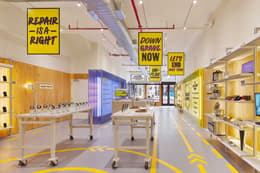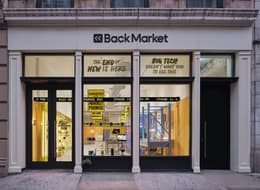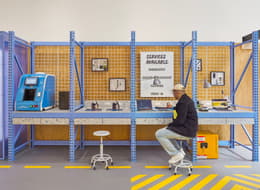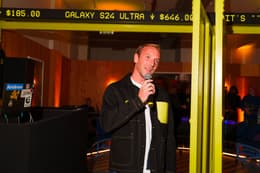
Earlier this month Back Market opened its first ever physical retail store, which is based in New York City’s SoHo. Writer Dylan Green explores how this retail space will elevate the refurbished tech world.
When was the last time you walked into a tech store and it felt both fun and accessible? Most modern storefronts are little more than sterile showrooms, where getting a hold of a specialist is a hassle and everything else— including functionality and curiosity—comes second to walls of incessant brand marketing. It’s fair to say these types of experiences, combined with near-constant high inflation, have created a collective disillusionment around physical retail.
Though big tech would have you expecting otherwise, a Talker Research study from July shows 80% of American consumers prefer to buy their household appliances refurbished. This, combined with a growing awareness around how e-waste negatively impacts the environment, has led to a refurb and second-hand boom over the last five years. But as eager as consumers are to save their money, own repairable devices, and reduce their carbon footprint, there’s currently a lack of physical stores catering to this specific market. It’s commonly accepted that U.S. consumers prefer to buy refurbished tech in-person. And now, for the first time ever, Back Market is here to meet these desires in the flesh.

Going inside Back Market’s NYC store
I had the opportunity to experience Back Market’s first-ever physical storefront, located at 449 Broadway in New York City’s SoHo neighborhood just north of Canal Street. Co-designed by creative agency Mythology, the store converts the quality assurance, appliance variety, and care for the planet the brand is known for into something real-world tangible. Historically, SoHo has been home to many retail stores and experiences, from street vendors and souvenir shops to fancy brand-name storefronts – this gives credence to Back Market’s decision to set up shop here and establish itself as the go-to electronic store and trading post in the area. To attempt to make history in a locale where creative traders have been making their mark for 100s of years now.
Immediately to my left as I walk inside, I’m met with a diagram showing the lifespan of the Circular Economy; from manufacturing and use to repairing, reusing, and recycling. Signs hang from the ceiling with life mantras: “Downgrade now,” “Un-plan obsolescence,” and “Repair is a right” written out in black and maroon. Meanwhile, to my right is the store’s flagship attraction: the service and cleaning station, where phones, laptops, and more electronic products can be fixed - not just bought - with on-sight iFixit tool kits.
Work terminals are painted blue, with broken computers and phones strewn about under various dioramas of deconstructed video game accessories, including a Nintendo Wii remote and a first-generation Game Boy. “Here, we emphasize to our customers that they have the right to repair,” Gervase Burkett, a technical expert doing device repairs and cleanings on the spot, explains.

Introducing futuristic retail concepts
Shortly after Burkett showed me a station dedicated to the FutureDial, a machine specifically made for testing smartphones—its faceplate was removed so customers can see devices old and new effectively having live open-heart surgery performed on them. The tiny arms and rotating platforms looked like something out of a version of Terminator that actually carries hope for the future of technology opposed to pure dread. Here, especially with the FutureDial, the embodiment of the Right to Repair movement was staring me right in the face.
“As an online marketplace, I can’t actually help you clean your device. I can’t physically change out your screen right there,” Lauren Benton, Back Market’s general manager for the US, elaborates further. “But here, well, we can flip this idea of retail on its head. Typically, it’s all about ‘buy, buy buy,’ but our mission is about everyone doing more with what they already have. Buying a refurbished device comes into that, but the first thing we want you to do is value what you actually have.”
This philosophy was clear from the second I began exploring the retail space. It’s deliberately designed as an upside down Apple Store; instead of a white, grey, and beige color palette, bright colors pop off of every surface, and sections are clearly marked and primed for people to truly interact. It’s as if this section is making the point that Fast Tech can only start to be dismantled when we birth retail experiences that truly attempt to quite literally slow the consumer down.

A community feel
A little further to the right there’s a handful of tables begging to be interacted with. The first one that caught my eye was the Retro Tech table, where I was able to play around with old-school graphing calculators, iPods with the iconic click wheels, and also snap a few pics with some vintage Polaroid cameras. Next to Retro Tech is a table and display for Google Fi, the tech company’s wireless service suitable for every phone available at this Back Market store. There’s even a section with a Playstation emulator, so you and a friend can fire up some Crash Team Racing or Tekken 3.
Near the back there’s one piece that brings the “market” aspect of Back Market full circle. Looming over just about everything else in the store there is a stock ticker, the kind you’d see outside of Wall Street, flashing the prices of specific devices and also one specifically cheeky message: “It’s Back Market, not ‘Black’ Market.” Unlike the black market, there’s nothing secretive or clandestine about what Back Market offers, and this feature succeeds in amplifying a feeling of buzzy community inside the store.
In a world numbed by instant gratification, Back Market’s debut store stands as a testament to not only bringing refurb and repair into the real world, but to all the care and craft that goes into it. Upcoming in-store events running through November include two talks with Kyle Wiens, the CEO of iFixit—one is a conversation on the state of repair, the other is a free workshop for anyone at any skill level. Other events include building sessions, crafts workshops, trade-in days that dovetail with giveaways, and further special guests. Yet at the heart of every event, and of the store itself, is the sense that if we can repair tech together then we can also change the world.

“‘Fast’ has destroyed our trust in how we shop, how we work, and even our trust in the most important thing to us: time,” Joy Howard, Chief Marketing Officer of Back Market, tells me. “With this store, we wanted to have our vision of a more sustainable, slower, simpler future made tangible. It’s a space for us to create, to repair, and to connect with each other.”
Thibaud Hug de Larauze, co-founder and CEO [pictured above] of the company, went one step further, emphasizing the importance of having the first of many Back Market stores in the heart of New York City: “If you had asked me if I’d have a shop in SoHo 11 years ago when I started this company in my basement, I would’ve laughed in your face. But we’ve always thought that bringing refurbished tech to people should be the norm. For the first time, we’re here, offline, with real people, and it’s so much more fun. The best is yet to come, and it all starts here in the Big Apple.”
The Back Market store is open through Sunday, December 21st. Check out the site for more info.















